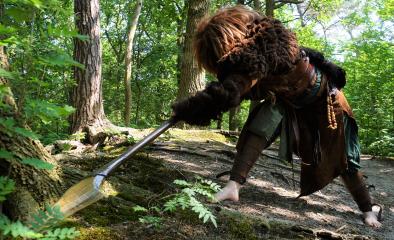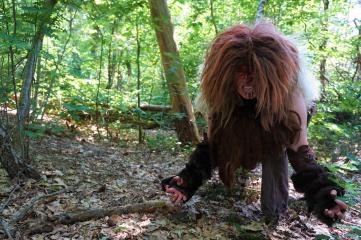The Shanata are one of the fifteen standard races .
They have an average time of life of 50 years, but Shanata can "reset" their life cycle by living fused with a tree for half a year. They can do this 8 times on average but they lose more wisdom every time, slowly turning into savages with each passing cycle.
Shanata Life Cycle
Shanata live for roughly 50 years but can reset there lifespan by living under a tree for half a year. The Shanata digs a hole under the tree and buries him or herself in it. Once closed off and safe The Shanata will connect with the roots of the tree for life support. During the 6 months under ground the Shanata will form a cocoon out if its old skin and fur. Slowly all cells inside its body will start to create a huge amount of stem-cells that will replace most other cells in the body. The cells with the most entropy in it will be discarded in to the walls of the cocoon. A Shanata can rejuvenate its whole body except for its bones and brain-cells. Going through this cycle is very stress full for the body of a Shanata. The brain cells will also die out about twice as fast during the cycle.
Shanata that have lived trough 4 or 5 of these cycles get increasingly asocial and dumb. Most Shanta who have gone through their 7th cycle will start to behave as wild predatory animals. Shanata are not biologically strong enough to live trough their 10th cycle. Most of the Shanata naturally die at their 8th or 9th cycle.
Physical appearance
Shanata have pointy ears, and sometimes have long sharp claws and fangs. Shanata naturally grow thick fur, long hair and long manes.
When a Shanata fuses with a tree to reset the life cycle his skin will thicken and the claws and fangs will grow. Making them look more like wild animals with each passing cycle. After a Shanata has fused with a tree it will loose its fur for a period of time. The climate of their habitat determines the time it takes for the fur to regrow.
Biology
The Shanata are energetic and highly territorial. They have less emotions when compared to the other races. Shanata babies are self sufficient to a certain degree hours from birth. They have the capacity to crawl and find bugs to eat and learn how to walk within the first few days.
Diet
Shanata are omnivorous. Shanata can eat other shanata with a low risk of getting sick.

